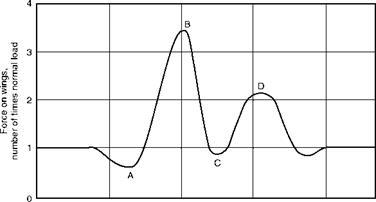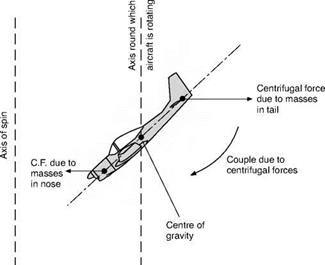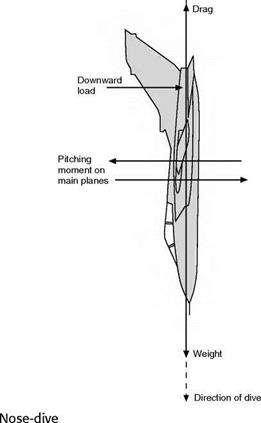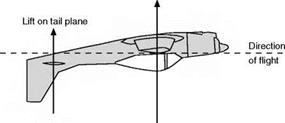Aerobatics
The usual aerobatics are loops, spins, rolls, sideslips, and nose-dives, to which may be added upside-down flight, the inverted spin, and the inverted loop. The manoeuvres may also be combined in various ways, e. g. a half loop followed by a half roll, or a half roll followed by the second half of a loop.
There are many reasons why aerobatics should be performed in those types of aircraft which are suitable for them. They provide excellent training for accuracy and precision in manoeuvre, and give a feeling of complete mastery of the aircraft, which is invaluable in all combat flying. They may also be used for exhibition purposes, but modern aircraft are so fast and the radius on which they can turn or manoeuvre is so large that, in many ways, they provide less of a spectacle than older types. Not least, aerobatics increase the joy and sensations of flight to the pilot himself – not quite so much to other occupants of the aircraft!
The movements of the aeroplane during these aerobatics are so complicated that they baffle any attempt to reduce them to the terms of simple mechanics and, indeed, to more advanced theoretical considerations, unless assumptions are made which are not true to the facts.
Figs 8.8 and 8.9 (overleaf) show the approximate path travelled by a slow type of aircraft during a loop and the corresponding ‘accelerometer’ diagram which shows how the force on the wings varies during the manoeuvre. From this it will be seen that, as in many manoeuvres, the greatest loads occur at the moment of entry. Notice also that even at the top of the loop the load is very little less than normal – that is to say, that the pilot is sitting firmly on his seat in the upward direction, the loads will still be in the same direction relative to the aircraft as in normal flight, and our plumb bob will be hanging upwards!
|
0 112 1 minute 4 2 4 Accelerometer record |
Fig 8.9 Accelerometer diagram for a loop
Only in a bad loop will the loads at the top become negative, causing the loads on the aircraft structure to be reversed and the pilot to rely on his straps to prevent him from falling out.
Simple theoretical problems can be worked out on such assumptions as that a loop is in the form of a circle or that the velocity remains constant during the loop, but the error in these assumptions is so great that very little practical information can be obtained by attempting to solve such problems, and it is much better to rely on the results of practical experiments.
A Spin (Fig. 8.10) is an interesting manoeuvre, if only for the reason that at one time there stood to its discredit a large proportion of all aeroplane accidents that had ever occurred. It differs from other manoeuvres in the fact that the wings are ‘stalled’, – i. e. are beyond the critical angle of attack, and this accounts for the lack of control which the pilot experiences over the movements of the aeroplane while spinning; it is, in fact, a form of ‘auto-rotation’ (Fig. 8.11), which means that there is a natural tendency for the aeroplane to rotate of its own accord. This tendency will be explained a little more fully when dealing with the subject of control at low speeds in the next chapter. In a spin the aeroplane follows a steep spiral path, but the attitude while spinning may vary from the almost horizontal position of the ‘flat’ spin to the almost vertical position of the ‘spinning nose-dive’. In other words the spin, like a gliding turn or steep spiral is composed of varying degrees of yaw, pitch and roll. A flat spin is chiefly yaw, a spinning nose-dive chiefly roll. The amount of pitch depends on how much the wings are banked from the horizontal. In general, the air speed during a spin is comparatively low, and the rate of descent is also low. Any device, such as slots, which tend to prevent stalling, will also tend to minimise the danger of the accidental spin and may even make it impossible to carry out deliberately. The area and disposition of the
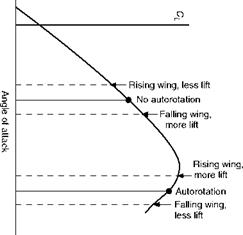

|
|
Fig 8.12 Tendency of a spin to flatten owing to centrifugal force fin, rudder, and tail plane exert considerable influence on the susceptibility of the aeroplane to spinning.
Many of the terrors of a spin were banished once it was known just what it was. We then realised that in order to get out of a spin we must get it out of the stalled state by putting the nose down, and we must stop it rotating by applying ‘opposite rudder’. In practice, the latter is usually done first, because it is found that the elevators are not really effective until the rotation is stopped. The farther back the centre of gravity, and the more masses that are distributed along the length of the fuselage, the flatter and faster does the spin tend to become and the more difficult is it to recover. This flattening of the spin is due to the centrifugal forces that act on the masses at the various parts of the aircraft (Fig. 8.12). A spin is no longer a useful combat manoeuvre, nor is it really a pleasant form of aerobatics, but since it is liable to occur accidentally, pilots are taught how to recover from it.
During a roll (Fig. 8.13) the aeroplane rotates laterally through 360°, but the actual path is in the nature of a horizontal corkscrew, there being varying degrees of pitch and yaw. In the so-called slow roll the loads in the 180° position are reversed, as in inverted flight, whereas in the other extreme, the barrel roll, which is a cross between a roll and a loop, the loads are never reversed.
In a sideslip (Fig. 8.14) there will be considerable wind pressure on all the side surfaces of the aeroplane, notably the fuselage, the fin and the rudder, while if the planes have a dihedral angle the pressure on the wings will tend to bring the machine on to an even keel. The sideslip is a useful manoeuvre for
|
Fig 8.13 A roll
losing height or for compensating a sideways drift just prior to landing, but, as already mentioned, modern types of aircraft do not take very kindly to sideslipping. The small side area means that they drop very quickly if the sideslip is at all steep, and the directional stability is so strong that it may be impossible to hold the nose of the machine up (by means of the rudder), and the dropping of the nose causes even more increase of speed.
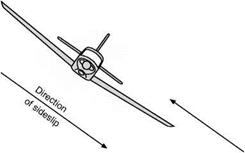 |
A nose-dive is really an exaggerated form of gliding; the gliding angle may be as great as 90° – i. e. vertical descent – although such a steep dive is rarely performed in practice. If an aeroplane is dived vertically it will eventually reach a steady velocity called the terminal velocity. In such a dive the weight is entirely balanced by the drag, while the lift has disappeared. The angle of attack is very small or even negative, there is a large positive pressure near the leading edge on the top surface of the aerofoil, tending to turn the aeroplane on to its back, and this is balanced by a considerable ‘down’ load on the tail plane (Fig. 8.15, overleaf). In such extreme conditions the terms used are apt to be misleading; for instance, the ‘down’ load referred to is horizontal, while the lift, if any such exists, will also be horizontal. The terminal velocity of modern aeroplanes is very high, and it makes little difference whether the engine is running or not. They lose so much height in attaining the terminal velocity that, in practice, it is doubtful whether it can ever be reached. As was only to be expected, the problems which accompany the attainment of a speed near to the speed of sound first made themselves felt in connection with the nose-dive, especially at high altitudes. At that time these compressibility effects were a special feature of nose-diving, but there was one consoling feature – as one got nearer the earth, terminal velocities were lower (owing to the greater
|
і і і
|
density), and the speed of sound was higher (owing to the higher temperature). So if one got into trouble high up, there was always a chance of getting out of it lower down. But nowadays, when more and more aircraft can exceed the speed of sound in level flight, and when compressibility troubles are no longer associated with fears of the unknown, these ideas are out of date, and the whole subject of flight at and above the speed of sound will be considered in Chapters 11 and 12.
The nose-dive, and the pulling-out of a nose-dive, are two entirely different problems, and the latter has already been fully dealt with.
Inverted manoeuvres
Real upside-down flight (Fig. 8.16) is not so often attempted as is commonly supposed, and should be distinguished from a glide in the inverted position,
which does not involve problems affecting the engine. If height is to be maintained during inverted flight, the engine must, of course, continue to run and this necessitates precautions being taken to ensure a supply of fuel and, with a piston engine, the proper functioning of the carburettor. The aerofoil will be inverted, and therefore, unless of the symmetrical type, will certainly be inefficient; while in order to produce an angle of attack, the fuselage will have to be in a very much ‘tail-down’ attitude. The stability will be affected, although some aircraft have been more stable when upside-down than the right way up, and considerable difficulty has been experienced in restoring them to normal flight. In spite of all the disabilities involved, some aeroplanes are capable of maintaining height in the inverted position (Fig. 8C, overleaf).
The inverted spin is in most of its characteristics similar to the normal spin; in fact, in some instances pilots report that the motion is more steady and therefore more comfortable. As in inverted flight, however, the loads on the aeroplane structure are reversed and the pilot must rely on his straps to hold him in the machine.
The inverted loop, or ‘double bunt’, in which the pilot is on the outside of the loop (Fig. 8.17, overleaf), is a manoeuvre of extreme difficulty and danger. The difficulty arises from the fact that whereas in the normal loop the climb to the top of the loop is completed while there is speed and power in hand and engines and aerofoils are functioning in the normal fashion, in the inverted loop the climb to the top is required during the second portion of the loop, when the aerofoils are in the inefficient inverted position. The danger is incurred because of the large reversed loads and also because of the physiological effects of the pilot’s blood being forced into his head. It was a long time before this manoeuvre was successfully accomplished, and once it had been, so many foolhardy pilots began to attempt it – often with fatal results – that it had to be forbidden, except under very strict precautions and regulations.
|
Lift on wings due to angle of attack
|

Fig 8C Inverted flight (By courtesy of ‘Flight’)
 |
|
And to illustrate upside-down flight, the Hurricane of the Second World War; note the tail-down attitude usually associated with inverted flight.
‘Bumpy’ weather
In addition to the loads incurred during definite aerobatics, all aircraft are required to face the effects of unsteady weather conditions. Accelerometer records show that these may be quite considerable, and they must certainly be reckoned with when designing commercial aircraft. Where aeroplanes are, in any case, required to perform aerobatics, they will probably be amply strong enough to withstand any loads due to adverse weather. The conditions which are likely to inflict the most severe loads consist of strong gusty winds, hot sun, intermittent clouds, especially thunder clouds in which there is often considerable turbulence, and uneven ground conditions; a combination of all these factors will, almost certainly, spell a ‘rough passage’. The turbulence and up- currents that may be encountered in severe thunderstorms and in cumulo-nimbus clouds can sometimes be such as to tax the strength of the aeroplane and the flying skill of the pilot.











